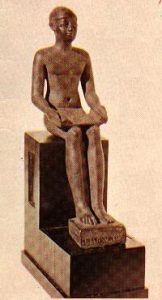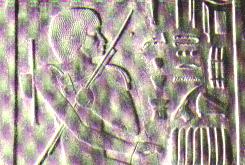DISEASES OF THE EYE:
Eye care of the workmen was demonstrated in several papyri and tomb inscriptions. Foreign body removal and treatment of eye inflammations and minor operations were so common. The Ebers Papyrus says:
“Another, not to let a hair grow into the eye after it has been pulled out: Terebinth resin … It can not grow again”.
Night blindness was cured by roasted and crushed ox liver, which is known to be very rich in vitamin A. Cataract (loss of eye lens transparency) was so named as the Latins thought it was due to a liquid flowing from the brain into the eyes. The Egyptians called it “rise of water”, denoting a same false understanding as Latins did centuries later. It was treated by a mixture of tortoise brain and honey. The first surgery was performed in Alexandria during the Ptolomies’ era (31st dynasty).
DENTAL DISEASES:
Numerous papyri enumerate prescriptions to dental diseases, such as pyorrhea, loose teeth, dental caries and abscesses. Surgically produced holes to drain an abscess under the 1st molar were found in the mandible of a 4th dynasty mummy (2625 - 2510 BC). A loose tooth fixed with a gold wire bridge to a neighboring sound tooth was discovered in another mummy of the same dynasty in Giza. Artificial teeth holding a maxillary bridge by a silver wire was also found in the late period (Greco-Roman). Tooth extraction, treatment of mouth ulcers and treatment of jaw dislocation were dealt with in the Edwin Smith and Ebers Papyri.
The knowledge of the Egyptian physicians to chemistry was so vast that some would attribute the origin of the word “chemistry” to “Kemet”, the ancient name of Egypt. Drugs of different sources were used. Mineral, as sulfur, antimony and zinc were used especially in eye and skin ointments. Animal products, as ox meat and liver as well as more than 160 plants (many still in use) were used in the form of pills, powders or suppositories (rectal and vaginal). Among the common plants used were senna, sycamore, castor oil, acacia gum, mint and linseed. Yeast was used for indigestion and externally for leg ulcers.
Prescriptions were too far from primitive, almost sticking to the same guidelines physicians apply today. The dosage was adjusted to patient’s age
“If it is a big child, he should swallow it like a draught, if he is still in swaddles, it should be rubbed by his nurse in milk and thereafter sucked on 4 days”. The timing of administration was not disregarded in a prescription “… and the eye is painted therewith in the evening, its other half is dried, finely ground, and the eye is painted therewith in the morning”.
The duration of treatment in the Smith Papyrus was considered as “until he recovers”, “until the period of his injury passes by” or “until thou knowst that he has reached decision point”. In the Ebers Papyrus, the duration was more specified.
During the pyramid building, workers were given enormous amounts of radish, garlic and onion. Herodotus has mentioned in his second book, Euterpe:
“There is an inscription in Egyptian characters on the pyramid which records the quantity of radishes, onions, and garlic consumed by the laborers who constructed it; and I perfectly well remember that the interpreter who read the writing to me said that the money expended in this way was 1600 talents of silver”.
Only during the 20th century AD when an antibiotic preparation (Raphanin) has been extracted from radish, and Allicin and Allistatin from garlic and onion. A wise procedure undertaken in such an overcrowded camp.
The Egyptians have learned enemas from the Ibis, with its long beak with which it pushes water into its rectum to evacuate the bowel.
PSYCHIATRY:
Psychiatric diseases had their share in ancient Egyptian medicine. Depression was described as: “fever in the heart”, “dryness of the heart”, “falling of the heart”, “debility of the heart” and “kneeling of the mind”. The heart and mind were synonymous.
Hysterical disorders were described in the Kahun Papyrus as:
“the woman painted in her teeth and jaws, she knows not her mouth” and “a woman who loves bed, she does not rise, and does not shake it”.
The treatment was prescribed in the same papyrus, not too different than those applied nowadays. Psychotherapy was also applied by “incubation” or “temple sleep”, were a night was passed in a court of a temple. The temple at the island of Philae (Elephantine) was a center of sleep treatment. Dreams received during that period were interpreted in a psycho-religious way. This was conducted by divine healers, and enhanced by the temple atmosphere and the confidence in the supernatural powers of the deity.
ALTERNATIVE MEDICINE:
Alternative medical procedures were commonly practiced. Physiotherapy was depicted in a relief tomb in Saqqara showing massaging of a shoulder and a knee. Heliotherapy (exposure to ultraviolet sunrays) was mentioned in Ebers Papyrus for pain relief
“To relieve any painful part ……. The body is anointed and exposed to the sun”.
The Kalup Papyrus describes treatment by mud and clay
“Thou shalt do for it: rub her feet and legs with a mat (mud and clay) until she is well”.
Hydrotherapy (treatment by water) was also practiced. A sanatorium near Dendara temple has chambers equipped with basins. Water was poured over a statue, then flowed down a canal into the basins
THE PHYSICIANS:
The lay physician was named “swnw” (sunu). The profession was so organized, with the swnw over-ranked by Overseer of physicians (imy-r swnw), Chief physician (wr swnw), Eldest physician (smsw swnw), Inspector of physicians (shd swnw), and finally Overseer of Physicians of Upper and Lower Egypt. Some sunus were scribes, with the ability to to read medical texts, while others were not.
Magic physicians also existed, and were named “sau”. In between “swnw” and “sau” were priests of Sekhmet (a lioness-goddess, worshiped in Memphis as a creature of vengeance to punish mankind for his sins) who can inflict death and disease. Her priests used to heal those whom she punished, were medically qualified but not to bear the title “swnw”. The three types of physicians, with scientific medicine and magical one, coexisted peacefully.
There was no specific term to describe a surgeon or veterinary. However, specialty was pushed to the extremity, during the Old Kingdom and Late Period. There had been specialists for the eye, teeth, mouth, stomach pains and physicians of uncertain diseases. The title “Shepherd of the anus of the Pharaoh”, was encountered to men honored to administer enema to the king

Hesyre was the oldest known physician in history. He was the “Chief of Dentists and Physicians” at the time of King Zoser (3rd dynasty, 2700 - 2625 BC).
Peseshet was the oldest female physician in the world, practicing at the time of the pyramids (4th dynasty). She was titled “Lady Overseer of the Lady Physicians”, and supervised a corps of ladies who were qualified physicians, not midwives. She graduated midwives at the peri-ankh (medical school) of Sais.

Imhotep, the god of Healing.
Outstanding physicians were deified and worshiped. Temples were erected to to honor Imhotep, the physician and Vizier of King Zoser of the 3rd dynasty. He was an astronomer, architect and the builder of the Stepped Pyramid at Saqqara too. Imhotep was worshiped as the god of Healing and medicine. The Greeks later identified him with their own humanized god of healing, Asclepias. His statue stands today in the Hall of Immortals at the International College of Surgeons in Chicago.
MEDICAL INSTITUTES:
Since the 1st dynasty (3150 – 2925 BC), medical institutes called “peri-ankh” or “houses of life” existed. The most reputable ones where that of Imhotep at Memphis which has gained an international reputation particularly for its library till AD, the one at Sais where midwives were trained and afterwards themselves instructing physicians in the art of obstetrics, and the peri-ankh of Abydos which Ramses IV visited frequently its library. At least four other houses of life were attached to temples at Bubastis, Edfu, Tel-el-Amarna and Kom-Ombo.
Apart from being a teaching center, in those house medical books and papyri were written and preserved. The eldest books ever known, “Practical Medicine” and “Anatomical Book” were written by one of the kings of the 1st dynasty. Unfortunately, both were lost. By the Late Period, more specialized books had been written, that Clement of Alexandria (first president of the Christian school at Alexandria in AD 180) have found in its library six books devoted to specific aspects of medicine (anatomy, illnesses, surgical instruments, drugs, eye ailments and gynecology).
A code of ethics was followed, and probably an oath was made by physicians. In the tomb of Nenkh-Sekhmet, Chief of Physicians in the 5th dynasty, was written:
“Never did I do anything evil towards any person”.
Though these houses of life were under the direct protection of the Pharaoh himself, sometimes they were apt to suffer from royal caprice. The return of Cambyses, the Persian king of the 27th dynasty (525 BC) after military defeat in Upper Egypt, has coincided with the harvest festivals. He thought the Egyptian people were rejoicing his defeat, and in his rage, ordered the schools and temples to be destroyed. His successor, Darius, anxious to win the friendship of the Egyptians once more, ordered his private physician, Usaherresnet, to rebuild the "house of life". The inscription on the statue of Darius referring to this event concludes with these words:
"His Majesty did this because he knew the utility of this art, which restores life to all those who are ill".
MEDICAL SERVICES:
Sunus were appointed by the state, with medical attention granted for every citizen. During the building of the pyramids, medical services were available at high standards. Methen was the “swnw gereget” or “Colony Physician” appointed for their camp. Employees and workers enjoyed a medical insurance. An interesting text shows a temple employee being hit in his eye during work and was dismissed due to his physical incapacity. He was reinstated after pleading that the accident was a work injury, and demanded that the temple should pay all expenses of his medical care.
There was no fixed age for retirement except for physical incapacity. The Papyrus of Anastasi IV shows that workers had the right to claim a pension in case of invalidity. Sick leaves were allowed. A limestone dated the 40th regnal year of Ramses II (19th dynasty, 1240 BC) bears a list of 40 names of absenteeism, with the most frequent cause being illness. The Turin Papyrus informs that neither sick nor broken workers were commanded to lift stones. The working time schedule was fixed to 4 hours in the morning and 4 in the afternoon, with a meal and nap in between to avoid sunstroke.
Medical facilities were available at mines and quarries. The Sinai Stella gives the name of Chief Physician “Ren-ef-Seneb” among the expeditionary crew searching for copper and turquoise. Perhipidje was the Community Physician at Dair-el-Medina.
Data regarding military medicine is scarce. An inscript illustrates a man caring for the leg of his fellow in the rear of the battle of Kadesh (1274 BC). Hygienic disciplinary procedures were practiced for army personnel. Egypt was the first country in history to practice the tradition of hair trimming to avoid insect infestation. A tradition still practiced in modern armies.




